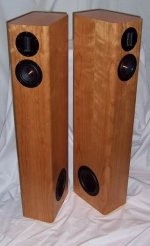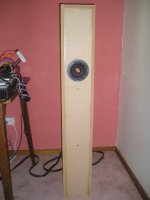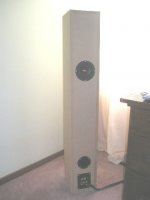Could do...I think.....but how does one then handle the difference in efficiency between the Extremis and the CSS drivers?
actually i was thinking to drive the fr's with a GC (which i have not yet completed!), and the extremis with a brytson 3bst...think that'll work out alright?
That should work fine. Whatever sounds best...you could try the other way around as well..actually i was thinking to drive the fr's with a GC (which i have not yet completed!), and the extremis with a brytson 3bst...think that'll work out alright
Bas Horneman said:...but I wonder how Raw Acoustics solved this.
More than once i've suggested to Al a plate amp in the HT3. The passive has some R in series with the WR125.
dave
Well... whatever works...works ofcourse..but I suppose one needs a pretty powerful amp to drive the HT3?The passive has some R in series with the WR125
But I thought WR125 was less efficient than the Extremis? So why was the resistor in series with the WR?
Bas Horneman said:But I thought WR125 was less efficient than the Extremis? So why was the resistor in series with the WR? [/B]
rated 86 vrs 85.6 -- pretty close actually,
Dan Wiggins designed the XO....
dave
Dan Wiggins designed the XO....
..........and yours truely has listened to it. Best design to come out of Raw so far, IMHO. Al has a real winner!
Best Regards,
TerryO
We had a listen to a single FR125: on its own it's very good at showing the difference between amplifiers and the faults in speakers that have more than 1 driver. A good reviewing tool.
We couldn't get it to work with an active X-over at 300 Hz, not sure why yet, but we did add a super tweeter, i thought the extra top end and extra dispersion at the top was wellcome.
A *stiff* transistor amp did well at contolling the bottom end (more enjoyable IMO) and demonstrated very good timing, at the expense of all soundstage and depth. With a small amount of harshness creeping in.
SE Valve amps gave a really natural soundstage and depth, and the *relative* lack of timing could have been down to the fact that the valve setup had less top end treble. A more natural sound, with less of the hifi impressive...
I guess you can't have the best of both worlds...
More experimentation time needed, I'm a BIG single driver fan now tho !
We couldn't get it to work with an active X-over at 300 Hz, not sure why yet, but we did add a super tweeter, i thought the extra top end and extra dispersion at the top was wellcome.
A *stiff* transistor amp did well at contolling the bottom end (more enjoyable IMO) and demonstrated very good timing, at the expense of all soundstage and depth. With a small amount of harshness creeping in.
SE Valve amps gave a really natural soundstage and depth, and the *relative* lack of timing could have been down to the fact that the valve setup had less top end treble. A more natural sound, with less of the hifi impressive...
I guess you can't have the best of both worlds...
More experimentation time needed, I'm a BIG single driver fan now tho !
New FR125 Design Underway
Well, I finally got around to routing my baffles and installing the drivers. I pulled together a quick and dirty crossover which is delivering suprisingly good results for just a few hours of playful "tweaking" by ear. The tweeter is the excellent Seas 27TDFC and the mid-woofers are both FR125s.
I ended up going with a TMM 2.5 configuration in a .75 cu ft ported enclosure from Parts Express. The port is 3.0" in length which should give a tuning frequency of approximately 50 hz. This yields between .5 and 1.0 db bump centered around 100 hz and a -3dB point of around 50hz.
So far the cross-over is a series cascaded 1st order low pass on the two woofers and a single cap with attenuation resistor on the tweeter circuit. Effectively first order x-overs all around 🙂! My intended goal of using two woofers to improve the power handling and efficiency of the speakers has worked well. It is still possible to bottom out the woofers but it really takes a lot more to do that now and at much greater volume.
I like these FR drivers much better than the WR. The bass response curve is much more smooth and therefore more natural sounding. The WR tended to have a big bump in low output compared to these FR drivers. It also seems that the top end of the FR is not just more extended but also smoother than that of the WR. I know the published frequency response shows improvements in the mid-band with the FR.
Compared to an FR playing on its own, I very much prefer the sound with the tweeter crossed in up top.
So far I don't have a single measurement, but I am really enjoying this basic x-over setup. Hopefully I'll have time to do the full SpeakerWorkshop battery of tests and simulations to share back with all of you what these speakers are actually doing and to tweak these x-overs.
Here are a few pics for your viewing pleasure for the time being:
Andrew
Well, I finally got around to routing my baffles and installing the drivers. I pulled together a quick and dirty crossover which is delivering suprisingly good results for just a few hours of playful "tweaking" by ear. The tweeter is the excellent Seas 27TDFC and the mid-woofers are both FR125s.
I ended up going with a TMM 2.5 configuration in a .75 cu ft ported enclosure from Parts Express. The port is 3.0" in length which should give a tuning frequency of approximately 50 hz. This yields between .5 and 1.0 db bump centered around 100 hz and a -3dB point of around 50hz.
So far the cross-over is a series cascaded 1st order low pass on the two woofers and a single cap with attenuation resistor on the tweeter circuit. Effectively first order x-overs all around 🙂! My intended goal of using two woofers to improve the power handling and efficiency of the speakers has worked well. It is still possible to bottom out the woofers but it really takes a lot more to do that now and at much greater volume.
I like these FR drivers much better than the WR. The bass response curve is much more smooth and therefore more natural sounding. The WR tended to have a big bump in low output compared to these FR drivers. It also seems that the top end of the FR is not just more extended but also smoother than that of the WR. I know the published frequency response shows improvements in the mid-band with the FR.
Compared to an FR playing on its own, I very much prefer the sound with the tweeter crossed in up top.
So far I don't have a single measurement, but I am really enjoying this basic x-over setup. Hopefully I'll have time to do the full SpeakerWorkshop battery of tests and simulations to share back with all of you what these speakers are actually doing and to tweak these x-overs.
Here are a few pics for your viewing pleasure for the time being:
Andrew
Attachments
Andrew... can you post some pics that haven't been posterized?
Did you add some bracing to the PE cabinet? The one i've seen was pretty, but not a great box...
dave
Did you add some bracing to the PE cabinet? The one i've seen was pretty, but not a great box...
dave
Dave:
Sorry about the photos. I will attach some new ones. I didn't realize how bad they were until just now.
The PE enclosures have an integrated vertical brace made of MDF. This is the second set of PE boxes I have purchased, the first being the .25 cu. ft. enclosures which I used for a pair of minimonitors with the WR and DX19 drivers. The overall fit and finish of the boxes is quite good. Compared to a custom purpose built enclosure they may not compare, but for a ready made and relatively inexpensive solution they are quite good for the money.
Andrew
Sorry about the photos. I will attach some new ones. I didn't realize how bad they were until just now.
The PE enclosures have an integrated vertical brace made of MDF. This is the second set of PE boxes I have purchased, the first being the .25 cu. ft. enclosures which I used for a pair of minimonitors with the WR and DX19 drivers. The overall fit and finish of the boxes is quite good. Compared to a custom purpose built enclosure they may not compare, but for a ready made and relatively inexpensive solution they are quite good for the money.
Andrew
ABS said:the first being the .25 cu. ft. enclosures
Those are the ones i had experience with... i'd recommend that they get extra bracing before use otherwise they will colour (pun intended) your opinion of the drivers you install in them.
dave
Re: New FR125 Design Underway
What crossover frequency to the tweeter?
ABS said:So far the cross-over is a series cascaded 1st order low pass on the two woofers and a single cap with attenuation resistor on the tweeter circuit. Effectively first order x-overs all around
What crossover frequency to the tweeter?
So what are your listening impressions of these speakers?
I have just built a dipole version MT-TL here is a photo.
Still experimenting, so cabinets not finished yet.
Dave is is advisable to add an inductor in series with the rear
speaker so as to only reproduce mid to low bass only.
I have just built a dipole version MT-TL here is a photo.
Still experimenting, so cabinets not finished yet.
Dave is is advisable to add an inductor in series with the rear
speaker so as to only reproduce mid to low bass only.
Attachments
The Saint said:just built a dipole version MT-TL
You mean bipole...
Dave is is advisable to add an inductor in series with the rear
speaker so as to only reproduce mid to low bass only.
Depends on your room & your tastes...
dave
In regard to the PE enclosure, I think it is good enough. I put my ear up to the walls of the cabinet and didn't hear any strange noises/vibrations. Sure, there are better enclosures but these suit me just fine . . . As a side note, I don't see any reason why additional braces couldn't be glued into the enclosure. Also, for another option, I noticed that Madisound is now selling an enclosure, the M2 I think, which has three horizontal shelf braces and the configuration of those braces (solid or open style) can be selected by the designer. I think those enclosures are around 1.3 cu.ft. and might be good for a big MTM or a TM with integrated sub woofer . . . Lots of options with that one.
I think the tweeter now has around 5uF total. The 1.0 woofer is running a .1mH inductor and, if memory serves me, the .5 woofer is running a .15 inductor. The two inductors are wired in series with the 1.0 woofer tapped off the connection between the two inductors with the .5 woofer tapped off the end of the .15 inductor. This means that the .5 sees the combined inductance of L1 + L2 or .25mH. Please note that I have only performed listening tests on these and I still need to take some actual measurements with Speaker Workshop and follow my standard process for cross over design.
The speakers sound surprisingly good in this configuration. Decent imaging, very good sound stage - surprisingly deep and fairly wide. They are not as good off-axis as the straight TM minimonitor I had previously built. The tweeter sounds really excellent. They can play very nice and loud with generally low bass distortion. However, on some tracks with significant output below the tuning frequency I was able to get the woofers to bottom out at high volume. I will plan to handle this issue with a dedicated sub-woofer.
Andrew
I think the tweeter now has around 5uF total. The 1.0 woofer is running a .1mH inductor and, if memory serves me, the .5 woofer is running a .15 inductor. The two inductors are wired in series with the 1.0 woofer tapped off the connection between the two inductors with the .5 woofer tapped off the end of the .15 inductor. This means that the .5 sees the combined inductance of L1 + L2 or .25mH. Please note that I have only performed listening tests on these and I still need to take some actual measurements with Speaker Workshop and follow my standard process for cross over design.
The speakers sound surprisingly good in this configuration. Decent imaging, very good sound stage - surprisingly deep and fairly wide. They are not as good off-axis as the straight TM minimonitor I had previously built. The tweeter sounds really excellent. They can play very nice and loud with generally low bass distortion. However, on some tracks with significant output below the tuning frequency I was able to get the woofers to bottom out at high volume. I will plan to handle this issue with a dedicated sub-woofer.
Andrew
- Home
- Loudspeakers
- Full Range
- FR125 New Design Options - Feedback Requested


